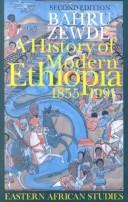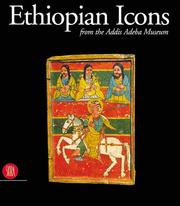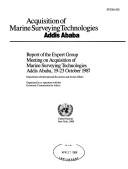Book
ISBN: 9782343152486 9782343152493 Year: 2018 Publisher: Paris : L'Harmattan,
Abstract | Keywords | Export | Availability | Bookmark
 Loading...
Loading...Choose an application
- Reference Manager
- EndNote
- RefWorks (Direct export to RefWorks)
C'est au milieu d'une région de montagnes et de prairies, jusqu'alors aux marges méridionales de l'espace national éthiopien, qu'est née Addis Abeba, vers 1886. D'abord simple camp royal et base logistique pour les conquêtes militaires, elle devient un « carrefour du monde ». Le texte met en lumière le rôle exercé par la volonté de reconnaissance de la souveraineté nationale, dans le processus particulier de fondation et de pérennisation de la capitale éthiopienne, ainsi que dans son développement au cours du XXe, notamment dans le domaine patrimonial. Cet ouvrage est complété par une abondante iconographie. Devenue la capitale permanente de l'Éthiopie vers 1900, Addis-Abeba a vu son rôle reconfirmé par l'occupant italien en 1936, lors de la fondation de l'Africa Orientale Italiana, puis à nouveau en 1941, après la Libération. Dans sa volonté de reconnaissance de la souveraineté nationale, la ville fut à nouveau mise en scène, architecturalement et monumentalement, en référence à l'histoire éthiopienne, comme le mythe fondateur du Kebrä Nägäst et le royaume antique d'Aksum. Faisant suite au premier tome, cet ouvrage s'attache à comprendre la construction de la ville depuis l'occupation italienne jusqu'au XXIe siècle, constituant la première somme publiée consacrée à la capitale éthiopienne.
City planning --- Urbanisme --- History. --- Histoire --- Addis Ababa (Ethiopia) --- Addis-Abeba (Ethiopie) --- History
Book
ISBN: 9783035628357 3035628351 Year: 2024 Publisher: Basel : Birkhäuser,
Abstract | Keywords | Export | Availability | Bookmark
 Loading...
Loading...Choose an application
- Reference Manager
- EndNote
- RefWorks (Direct export to RefWorks)
In den Ländern Afrikas findet sich in der Mitte des 20. Jahrhunderts eine außergewöhnliche Architektur, die wenig bekannt ist. Darin stehen Anklänge an den Art déco, den Internationalen Stil, den Brutalismus neben Einflüssen traditioneller Architektur. Viele der Architekten der Zeit waren europäischer Herkunft, fanden jedoch in der Auseinandersetzung mit ihrer Umgebung ganz eigene, ortsspezifische, expressive Lösungen, oft in Kooperation mit afrikanischen Architekten. Ein Schwerpunkt waren Bildungsbauten, die für die jungen Nationen Afrikas, die meist in den 1960er-Jahren ihre Unabhängigkeit von der Kolonialherrschaft erlangten, von zentraler Bedeutung waren. Während einige der vorgestellten Gebäude der Moderne bereits restauriert wurden, harren andere noch ihrer Wiederentdeckung. Zu den namhaften Autoren gehören Uta Pottgiesser (TH OWL, TU Delft), Ana Tostões (Universität Lissabon), Ola Uduku (Universität Liverpool) und andere Die faszinierenden Fotografien von Jean Molitor stecken voller Überraschungen und Neuentdeckungen Dokumentation von über 60 Gebäuden aus acht Ländern mit neuen Zeichnungen und Fotos Many African countries are home to extraordinary architecture that is virtually unknown. There are interpretations of Art Deco, International Style, Brutalism as well as of African vernacular architecture. Climate-responsive buildings with a fluidity of interior and exterior spaces play a large role. While many of these 20th century architects were of European origin, they were deeply influenced by their surroundings and found original, site-specific expressions, often in collaboration with African architects. A focus of the construction activities were educational buildings which played an important role for these young nations that mostly gained their independence in the 1960s. While some of the documented buildings have been restored, others are still awaiting reconstruction. Well-known contributors include Uta Pottgiesser (TH OWL, TU Delft), Ana Tostões (Lisbon University), Ola Uduku (University of Liverpool) et al. The stunning photography by Jean Molitor takes the reader on a journey across the continent Documentation of over 60 buildings from eight countries with new drawings and photographs
Book
ISSN: 01703196 ISBN: 3447040602 9783447040600 Year: 2000 Volume: 49 Publisher: Wiesbaden: Harrassowitz,
Abstract | Keywords | Export | Availability | Bookmark
 Loading...
Loading...Choose an application
- Reference Manager
- EndNote
- RefWorks (Direct export to RefWorks)
Addis Ababa (Ethiopia) --- History --- Addis Abeba (Ethiopia) --- ʼAdis ʼAbabā (Ethiopia) --- Atis Apēpa (Ethiopia) --- Ādīs Ābeba (Ethiopia) --- Addis Abbaba (Ethiopia) --- Addisaaba (Ethiopia) --- Finfinne (Ethiopia) --- History. --- Addis Ababa (Ethiopia) - History

ISBN: 1782047867 0821445723 9780821445723 9994452525 9789994452521 0821414402 9780821414408 0852557868 9780852557860 9994452525 9781782049869 178204986X 9781782047865 Year: 2016 Publisher: Oxford, [England] ; Athens, [Ohio] ; Addis Ababa, [Ethiopia] : James Curry : Ohio University Press : Addis Ababa University Press,
Abstract | Keywords | Export | Availability | Bookmark
 Loading...
Loading...Choose an application
- Reference Manager
- EndNote
- RefWorks (Direct export to RefWorks)
Bahru Zewde has updated the first edition, adding a new chapter and taking the history through to 1991.
'The new chapter enhances the value of the book as the best historical introduction to modern Ethiopia. The account of the Revolution, contained in 41 pages, is nuanced and worthy of attention in its own right... In short, the updating of an already indispensable book.'
Donald Crummey, Journal of Modern African Studies
North America: Ohio U Press; Ethiopia: Addis Ababa U Press
Ethiopia --- History --- HISTORY / Africa / East. --- 1855-1991. --- Addis Ababa. --- Ethiopia. --- History. --- JOURNAL OF MODERN AFRICAN STUDIES. --- Modern. --- Ohio. --- Revolution.
Book
ISBN: 0773419004 9780773419001 9780773413870 0773413871 Year: 2010 Publisher: Lewiston : The Edwin Mellen Press,
Abstract | Keywords | Export | Availability | Bookmark
 Loading...
Loading...Choose an application
- Reference Manager
- EndNote
- RefWorks (Direct export to RefWorks)
As a relatively new urban landscape, Addis Ababa possesses a rich cultural history that continues to develop today. Drawing on numerous first-person accounts of Addis Ababa from its inception to the present day, as well as the author's own field research, this work traces the development of the city from a military camp to the fastest-growing city in Africa. Careful attention is given to all elements of Addis Ababa, including its people, customs, geography, economy, psychology and its place in global culture. This book presents a holistic and diachronic view of the city and sets the stage for
Addis Ababa (Ethiopia) -- Economic conditions. --- Addis Ababa (Ethiopia) -- Ethnic relations. --- Natural resources -- Ethiopia -- Addis Ababa. --- Urbanization -- Ethiopia -- Addis Ababa. --- Urbanization --- Natural resources --- Addis Ababa (Ethiopia) --- Sociology & Social History --- Social Sciences --- Communities - Urban Groups --- National resources --- Resources, Natural --- Resource-based communities --- Resource curse --- Cities and towns, Movement to --- Urban development --- Urban systems --- Cities and towns --- Social history --- Sociology, Rural --- Sociology, Urban --- Urban policy --- Rural-urban migration --- Ethnic relations --- Economic aspects --- Economic conditions. --- Addis Abeba (Ethiopia) --- ʼAdis ʼAbabā (Ethiopia) --- Atis Apēpa (Ethiopia) --- Ādīs Ābeba (Ethiopia) --- Addis Abbaba (Ethiopia) --- Addisaaba (Ethiopia) --- Finfinne (Ethiopia)

ISBN: 8881186462 9788881186464 Year: 2000 Publisher: Milan: Skira,
Abstract | Keywords | Export | Availability | Bookmark
 Loading...
Loading...Choose an application
- Reference Manager
- EndNote
- RefWorks (Direct export to RefWorks)
Icons, Ethiopian --- Christian art and symbolism --- -Christian saints in art --- Ethiopian icons --- Art, Christian --- Art, Ecclesiastical --- Arts in the church --- Christian symbolism --- Ecclesiastical art --- Symbolism and Christian art --- Addis Ababa University. Ya'Ityopya tenatena meremer taqwam. --- Christian saints in art --- Religious art --- Symbolism --- Church decoration and ornament --- Addis Ababa University. --- Institute of Ethiopian Studies (Addis Ababa University) --- Institute for Ethiopian Studies (Addis Ababa University) --- Haile Sellassie I University. --- sculpting --- Sculpture --- Ethiopia --- Symbolism in art --- Icons, Ethiopian - Catalogs. --- Christian art and symbolism - Ethiopia - Medieval, 500-1500 - Catalogs. --- Christian saints in art - Catalogs --- Ethiopie --- Icônes --- Art
Book
ISBN: 9783944074047 3944074041 Year: 2013 Publisher: Berlin Ruby press
Abstract | Keywords | Export | Availability | Bookmark
 Loading...
Loading...Choose an application
- Reference Manager
- EndNote
- RefWorks (Direct export to RefWorks)
The School, The Book, The Town is a biography of an experiment undertaken in Ethiopia for nearly a decade, starting with the founding of a school, setting off a series of investigations assembled in a book, and leading to the construction of a town. A timeline running all through the book reveals how logical and consistent, but in some cases also chaotic and interrupted the story evolved. In an age of rapid urbanization, the city is everywhere. In the case of Ethiopia, as with so many other developing nations, architecture and urban design are brought face to face with a country undergoing radical, often painful transformations that put longstanding traditions to the test. The burning question here is how to modernize and yet maintain distinct cultural identities, while also trying to accommodate mass migration from rural regions to urban centers. In sum, the route followed here is one marked by a series of trials that leave nothing standing as it was.
Urbanization --- City planning --- Afrika --- Ethiopië --- Addis Ababa --- 373.67 --- 711.4 --- ETH Zurich (Eidgenössische Technische Hochshule Zurich) --- Architectuuronderzoek --- Onderzoek (architectuur) --- Stedenbouw
Book
ISBN: 3782003896 Year: 1977 Publisher: Frankfurt am Main Knecht
Abstract | Keywords | Export | Availability | Bookmark
 Loading...
Loading...Choose an application
- Reference Manager
- EndNote
- RefWorks (Direct export to RefWorks)
Missions --- #GBIB:SMM --- 266.3 <6> --- 266.3 <6> Missiografie--Afrika --- Missiografie--Afrika --- Christian missions --- Christianity --- Missions, Foreign --- Religion --- Theology, Practical --- Proselytizing --- Influence --- Ecclesiology --- Addis Abeba --- Addis Ababa

ISBN: 9211043034 Year: 1988
Abstract | Keywords | Export | Availability | Bookmark
 Loading...
Loading...Choose an application
- Reference Manager
- EndNote
- RefWorks (Direct export to RefWorks)
Engineering [Marine ] --- Marine engineering --- Marine technologie --- Marine technology --- Naval engineering --- Technologie marine --- Marine resources --- -Ocean --- Ocean resources --- Resources, Marine --- Sea resources --- Aquatic resources --- Commercial products --- Marine biology --- Natural resources --- Oceanography --- Congresses --- Economic aspects --- -Congresses --- Addis Ababa --- Technology

ISBN: 9780393338881 Year: 2010 Publisher: New York : W.W. Norton & Co.,
Abstract | Keywords | Export | Availability | Bookmark
 Loading...
Loading...Choose an application
- Reference Manager
- EndNote
- RefWorks (Direct export to RefWorks)
An epic tale of a father and two sons, of betrayals and loyalties, of a family unraveling in the wake of Ethiopia's revolution.
Families --- Families. --- Familles --- Family life --- Father-son relationship --- Fathers and sons --- Fathers and sons. --- Friendship --- Médecins --- Physicians --- Physicians. --- Pères et fils --- 1974. --- Addis Ababa (Ethiopia) --- Addis-Abeba (Éthiopie) --- Ethiopia --- Ethiopia. --- Éthiopie --- History --- Histoire

 Search
Search Feedback
Feedback About UniCat
About UniCat  Help
Help News
News